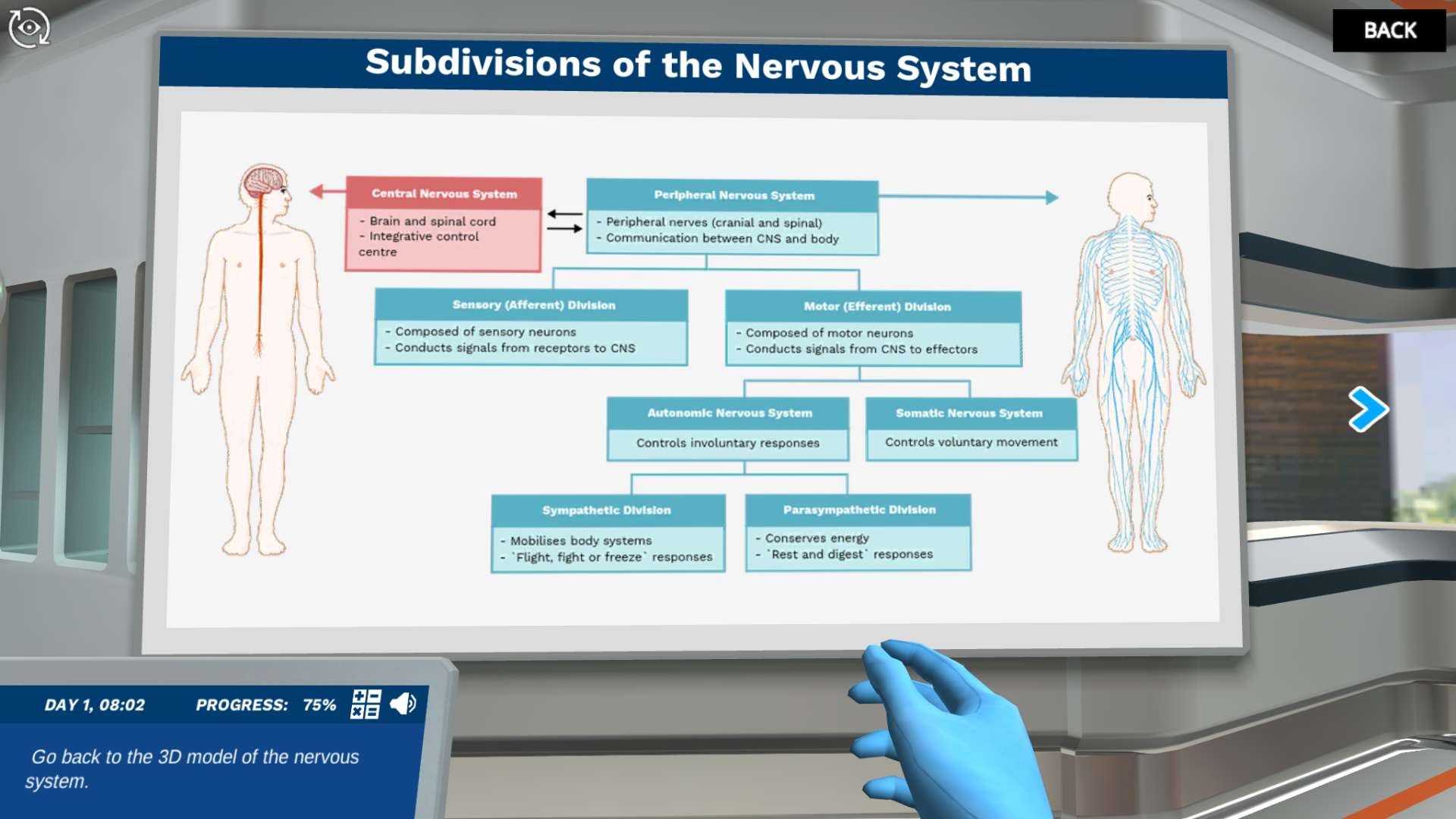Heading 1
Heading 2
Heading 3
Heading 4
Heading 5
Heading 6
Lorem ipsum dolor sit amet, consectetur adipiscing elit, sed do eiusmod tempor incididunt ut labore et dolore magna aliqua. Ut enim ad minim veniam, quis nostrud exercitation ullamco laboris nisi ut aliquip ex ea commodo consequat. Duis aute irure dolor in reprehenderit in voluptate velit esse cillum dolore eu fugiat nulla pariatur.
Block quote
Ordered list
- Item 1
- Item 2
- Item 3
Unordered list
- Item A
- Item B
- Item C
Bold text
Emphasis
Superscript
Subscript
About This Simulation
Step into Labster's Anatomy and Physiology lab to learn about the nervous system and its subdivisions. Explore the various bodily functions that the nervous system controls.
Learning Objectives
- Compare the structure and function of the central and peripheral nervous systems
About This Simulation
Lab Techniques
Related Standards
- Early Stage Bachelors Level
- EHEA First Cycle
- FHEQ 6
- SCQF 10
- SCQF 9
- US College Year 1
- US College Year 2
- US College Year 3
Learn More About This Simulation
This short, targeted simulation is adapted from the full-length “Gross Function of the Nervous System” simulation.
Without your nervous system, you wouldn’t be able to speak, walk, swallow, breathe ... or play Labster simulations! The nervous system is the human body’s control center, allowing us to process and react to external stimuli by regulating other systems. In this simulation, you will explore the nervous system and its subdivisions on a 3D model. Learn about the central and peripheral nervous systems
Identify key parts of the central and peripheral nervous systems on a 3D body scan. You will discover how they communicate with each other and influence day-to-day bodily functions. Dig deeper into the subdivisions of the peripheral nervous system to learn about sensory (afferent) and motor (efferent) divisions.
Relate the subdivisions to your own experiences
Study the difference between autonomic and somatic nervous systems and which organs and muscles are controlled by each. Is your hand reaching for another piece of chocolate really a voluntary action?
What happens to the nervous system when you are scared?
Finally, learn about the two subdivisions of the autonomic nervous system that are triggered when we find ourselves in stressful or relaxing situations. Choose between two scenarios: “fight or flight” or “rest and digest” and see how organs are affected under these circumstances. Can you observe your own body to define the what happens when sympathetic and parasympathetic responses are triggered?
For Science Programs Providing a Learning Advantage
Boost STEM Pass Rates
Boost Learning with Fun
75% of students show high engagement and improved grades with Labster
Discover Simulations That Match Your Syllabus
Easily bolster your learning objectives with relevant, interactive content
Place Students in the Shoes of Real Scientists
Practice a lab procedure or visualize theory through narrative-driven scenarios


FAQs
Find answers to frequently asked questions.
Heading 1
Heading 2
Heading 3
Heading 4
Heading 5
Heading 6
Lorem ipsum dolor sit amet, consectetur adipiscing elit, sed do eiusmod tempor incididunt ut labore et dolore magna aliqua. Ut enim ad minim veniam, quis nostrud exercitation ullamco laboris nisi ut aliquip ex ea commodo consequat. Duis aute irure dolor in reprehenderit in voluptate velit esse cillum dolore eu fugiat nulla pariatur.
Block quote
Ordered list
- Item 1
- Item 2
- Item 3
Unordered list
- Item A
- Item B
- Item C
Bold text
Emphasis
Superscript
Subscript
A Labster virtual lab is an interactive, multimedia assignment that students access right from their computers. Many Labster virtual labs prepare students for success in college by introducing foundational knowledge using multimedia visualizations that make it easier to understand complex concepts. Other Labster virtual labs prepare learners for careers in STEM labs by giving them realistic practice on lab techniques and procedures.
Labster’s virtual lab simulations are created by scientists and designed to maximize engagement and interactivity. Unlike watching a video or reading a textbook, Labster virtual labs are interactive. To make progress, students must think critically and solve a real-world problem. We believe that learning by doing makes STEM stick.
Yes, Labster is compatible with all major LMS (Learning Management Systems) including Blackboard, Canvas, D2L, Moodle, and many others. Students can access Labster like any other assignment. If your institution does not choose an LMS integration, students will log into Labster’s Course Manager once they have an account created. Your institution will decide which is the best access method.
Labster is available for purchase by instructors, faculty, and administrators at education institutions. Purchasing our starter package, Labster Explorer, can be done using a credit card if you are located in the USA, Canada, or Mexico. If you are outside of North America or are choosing a higher plan, please speak with a Labster sales representative. Compare plans.
Labster supports a wide range of STEM courses at the high school, college, and university level across fields in biology, chemistry, physics, and health sciences. You can identify topics for your courses by searching our Content Catalog.















